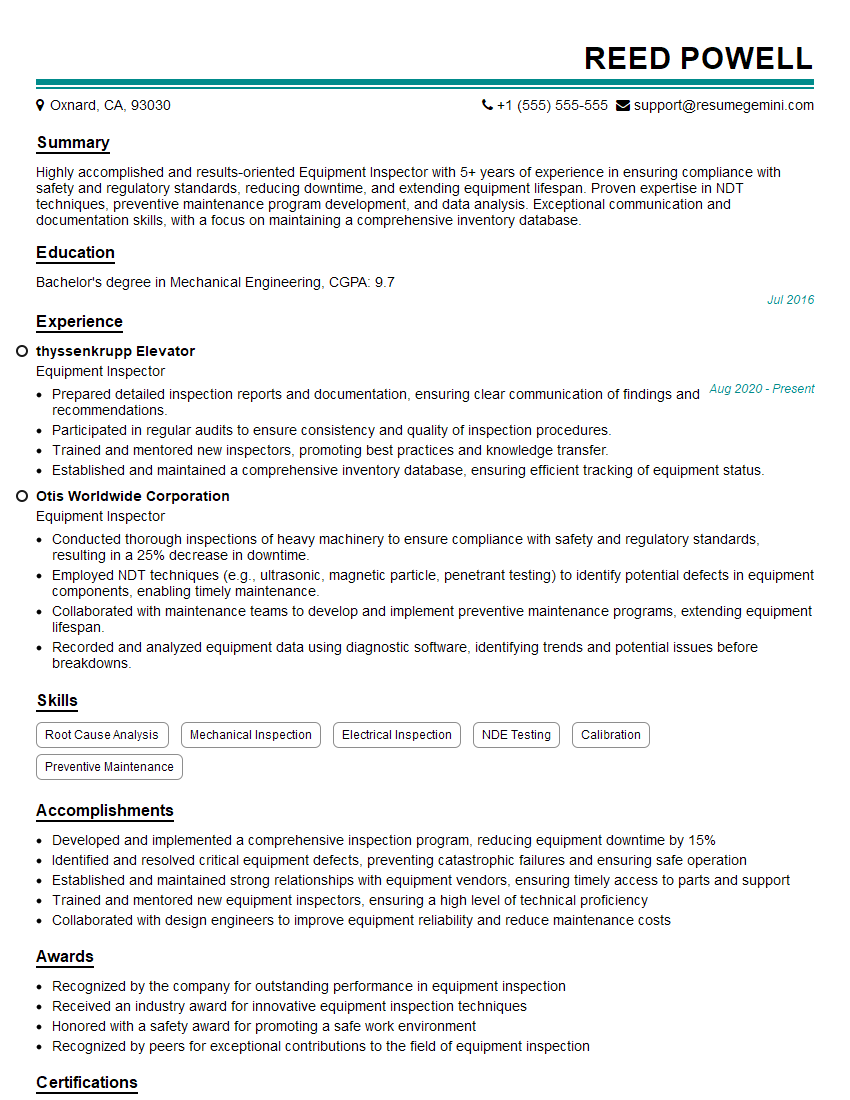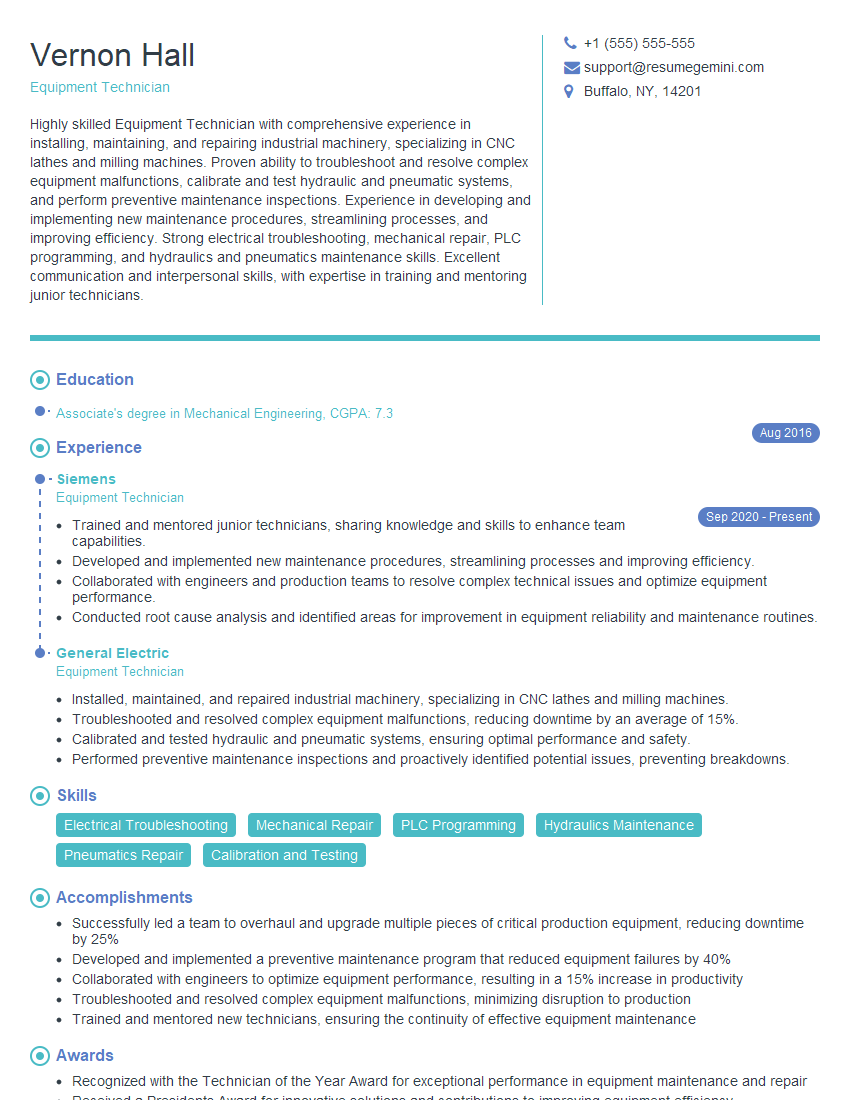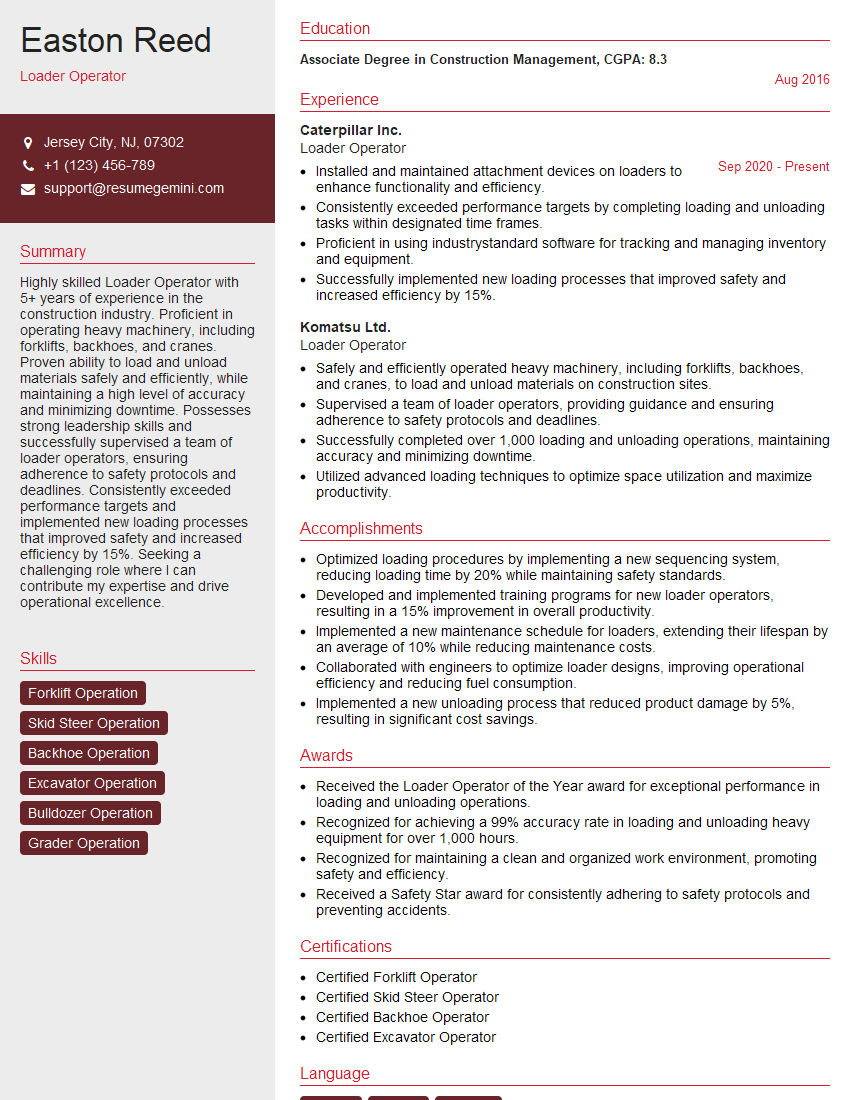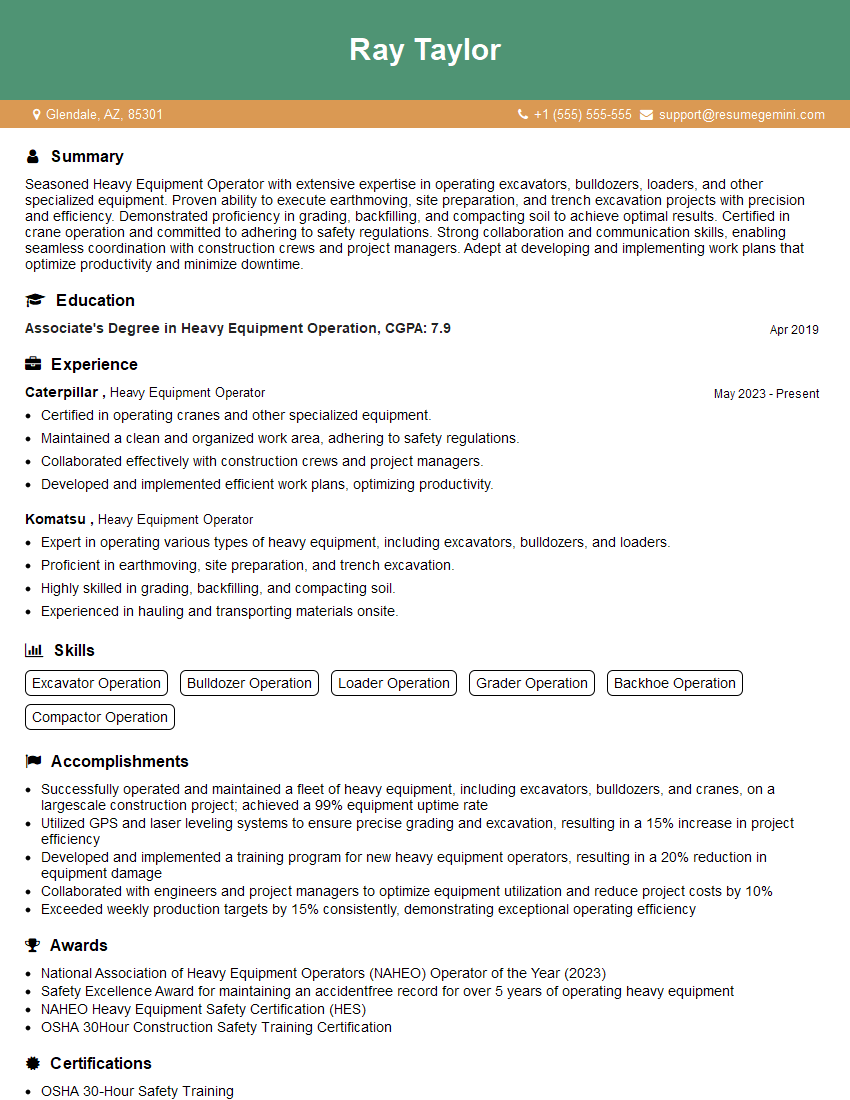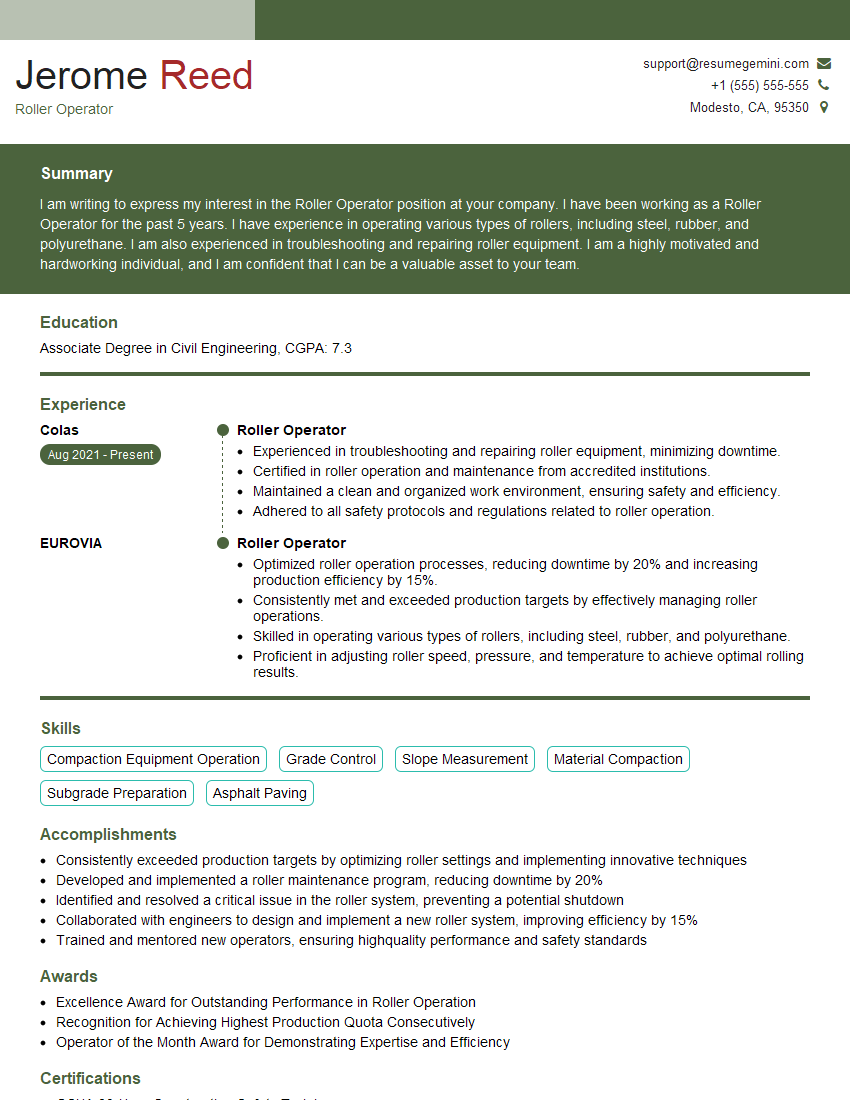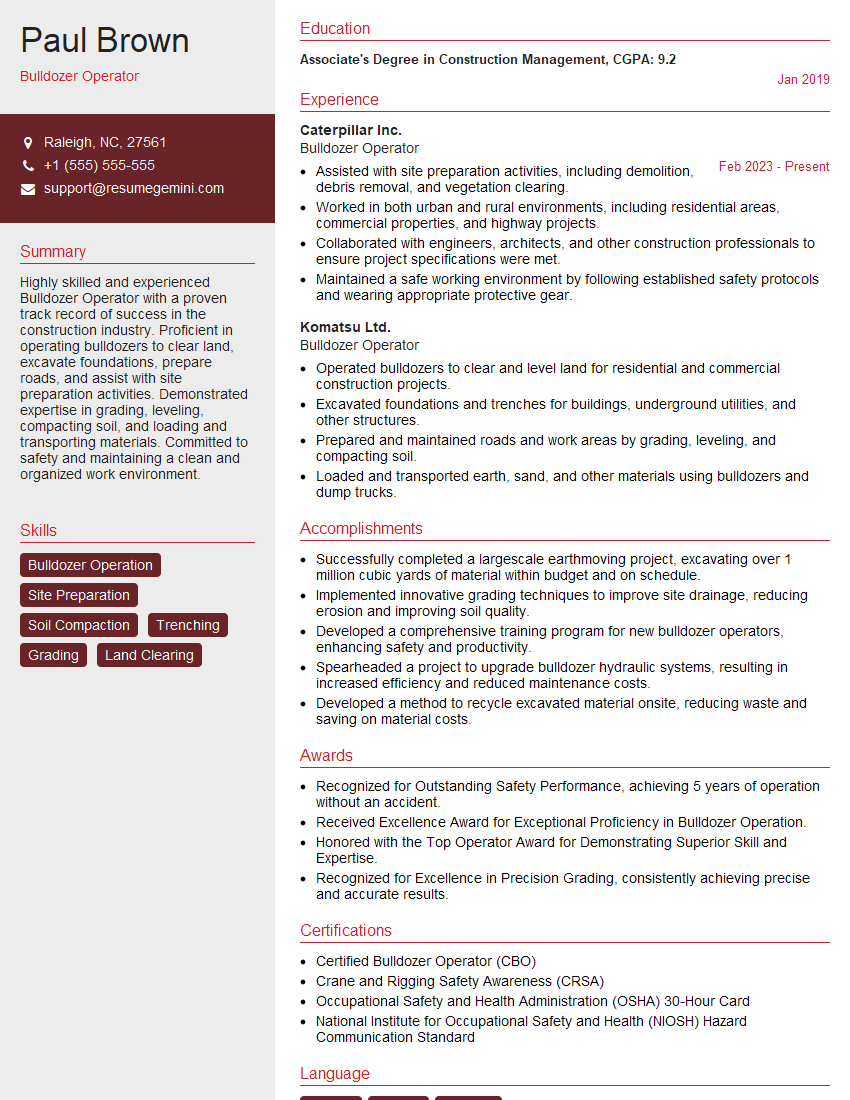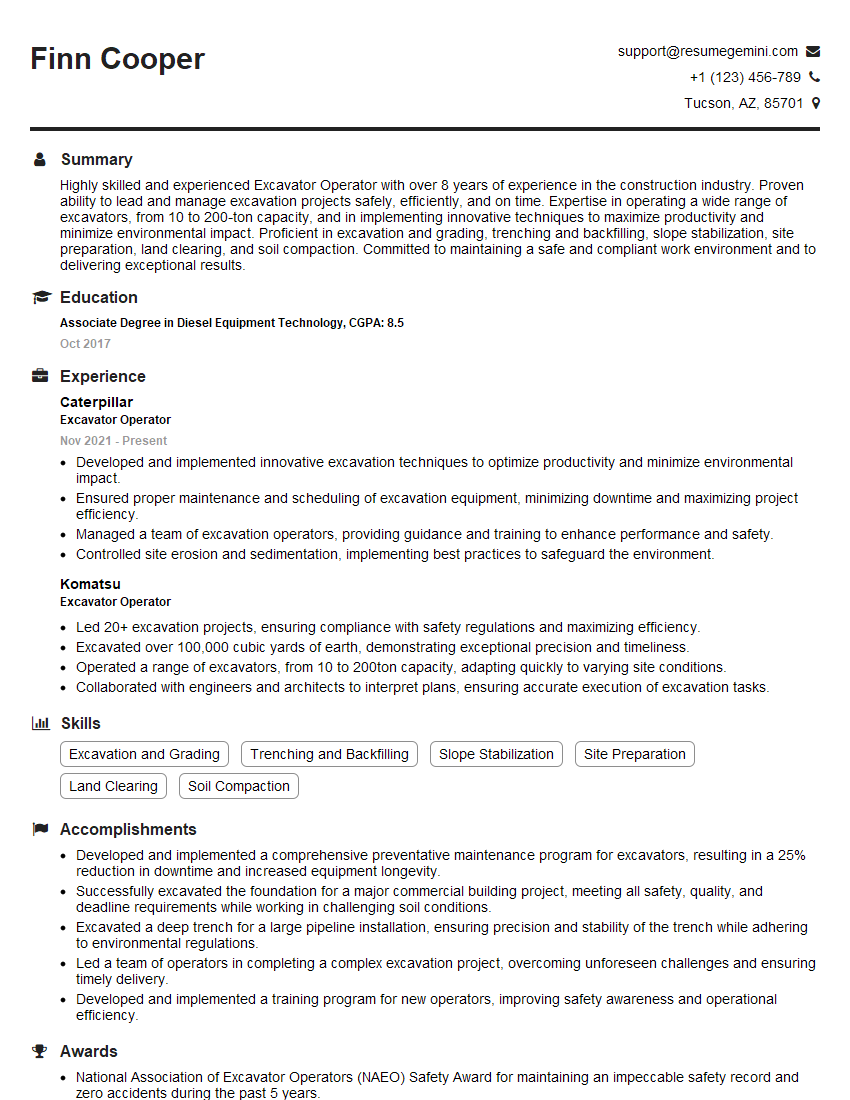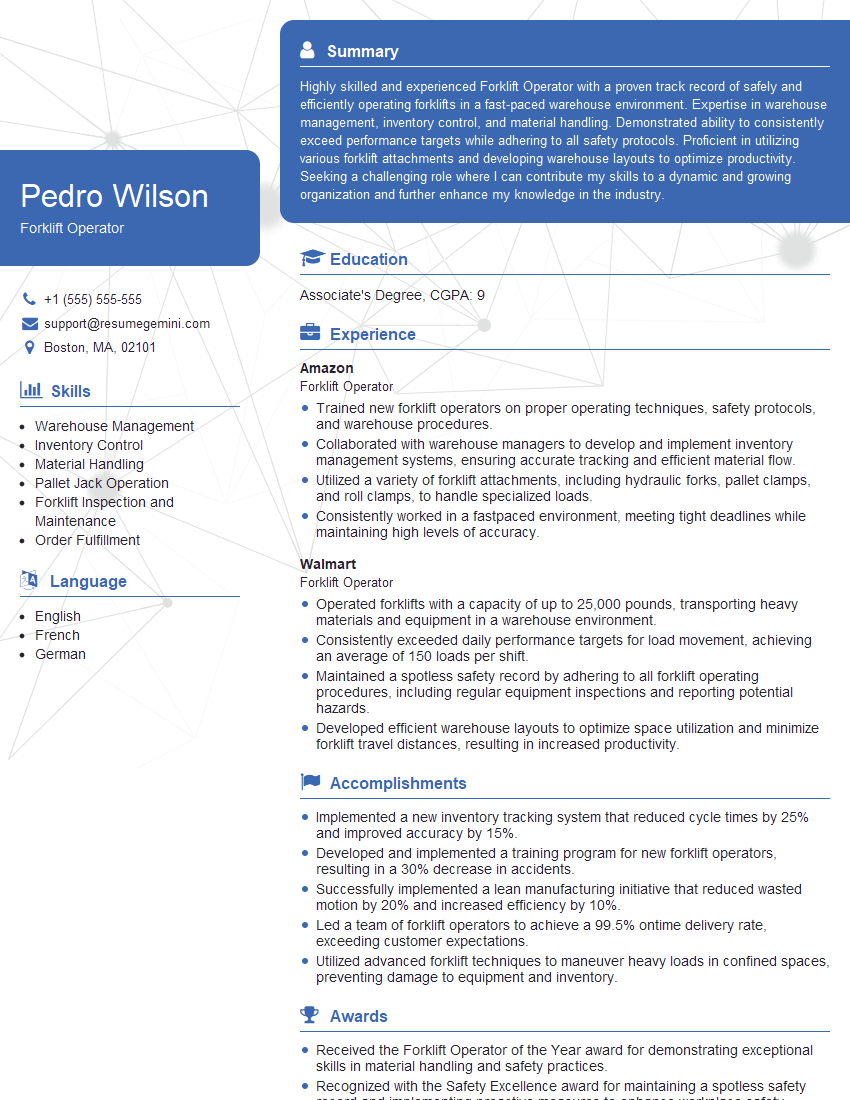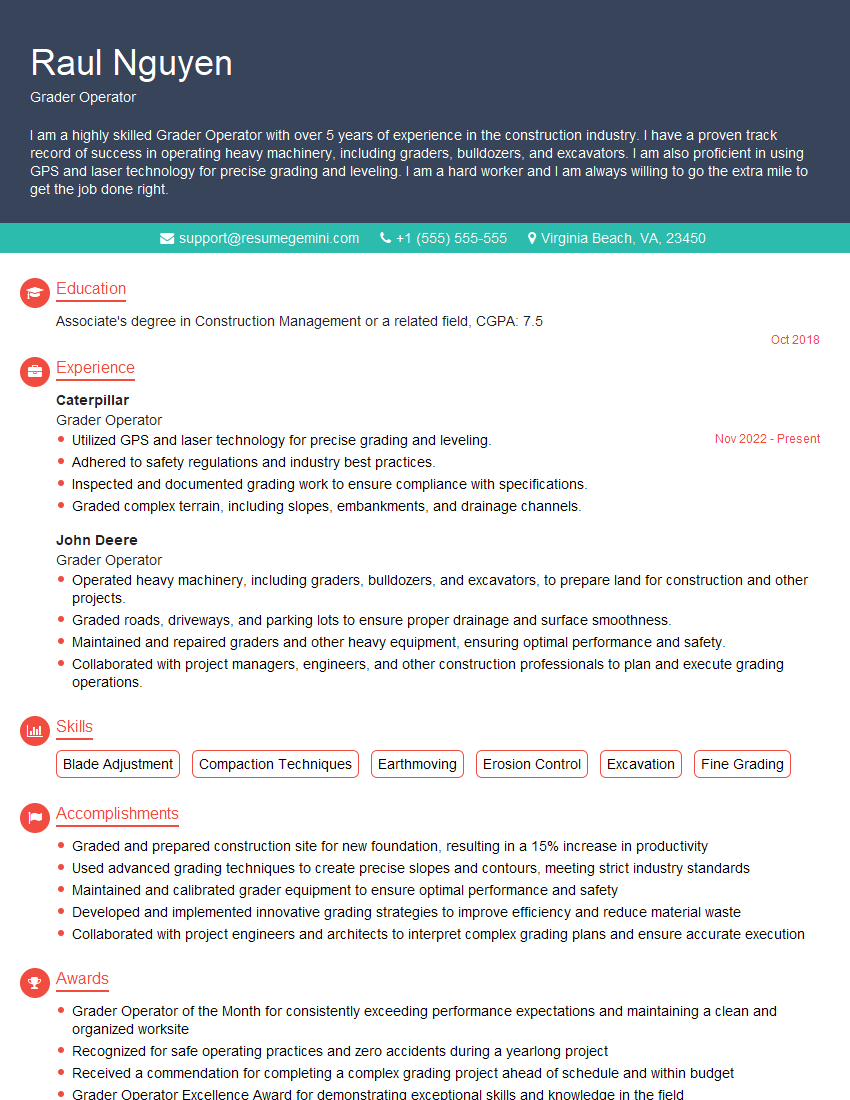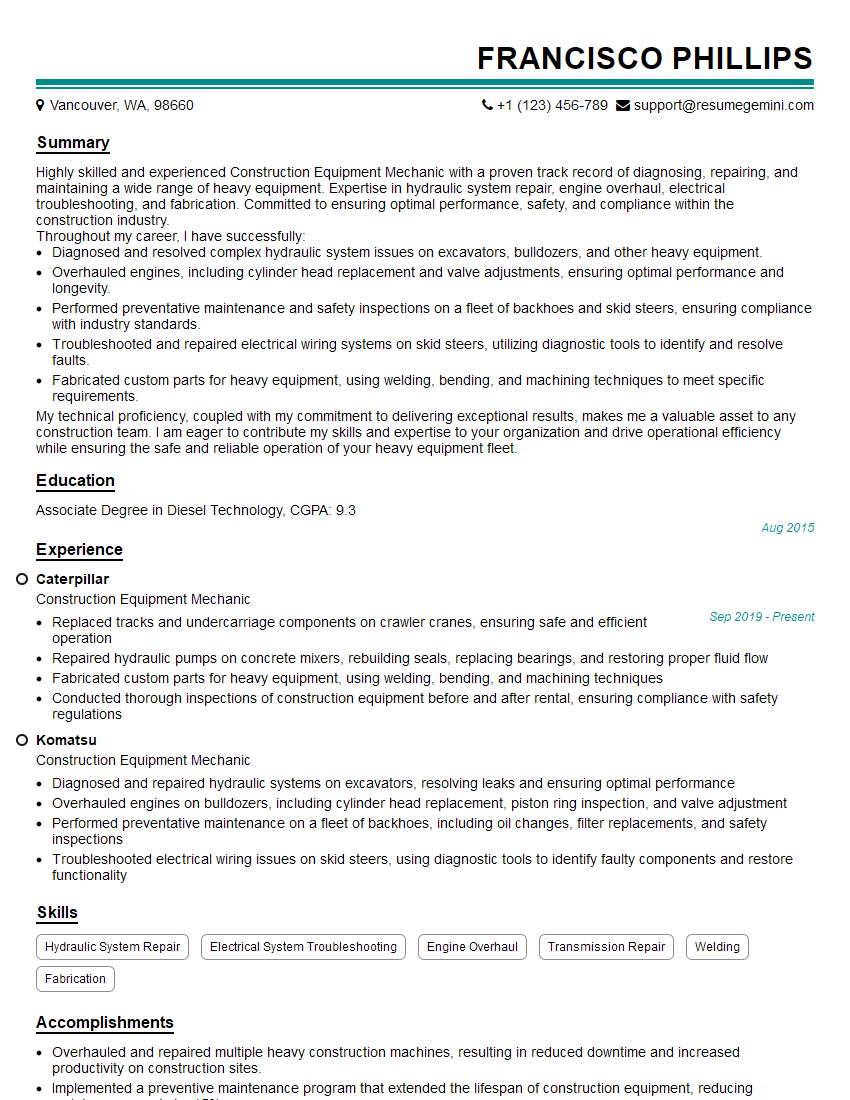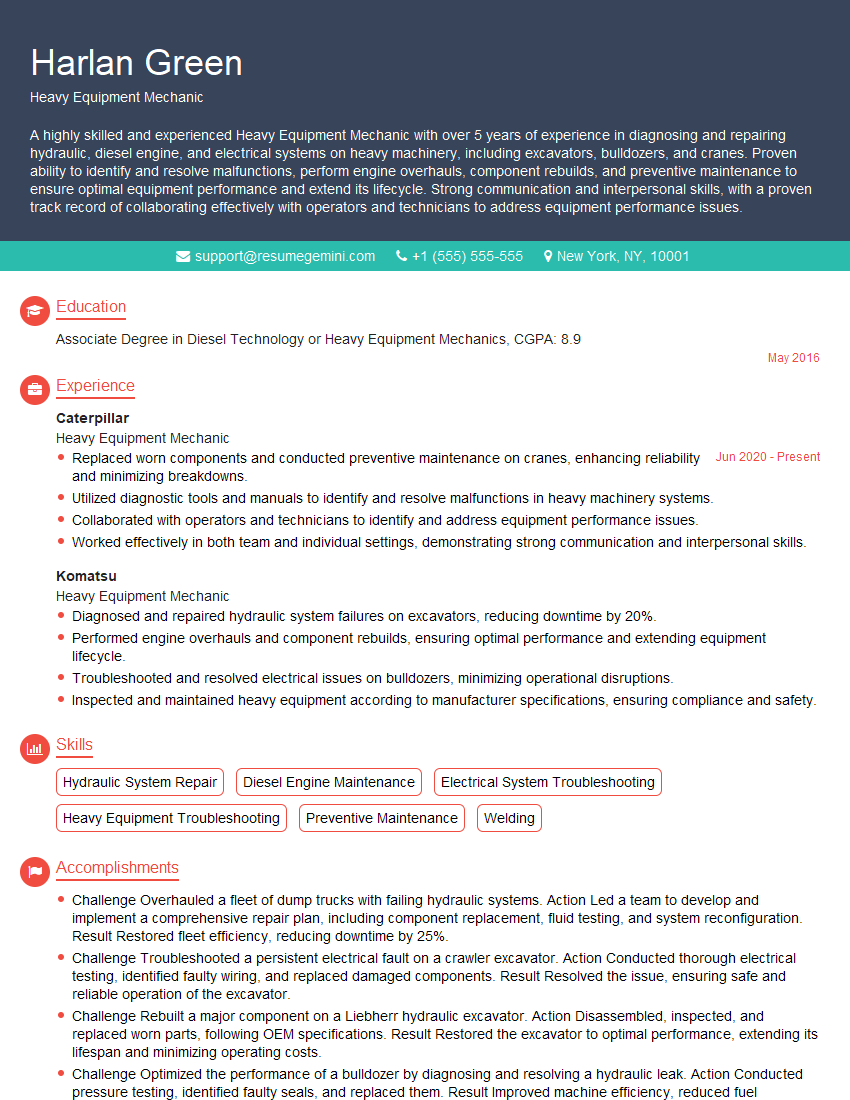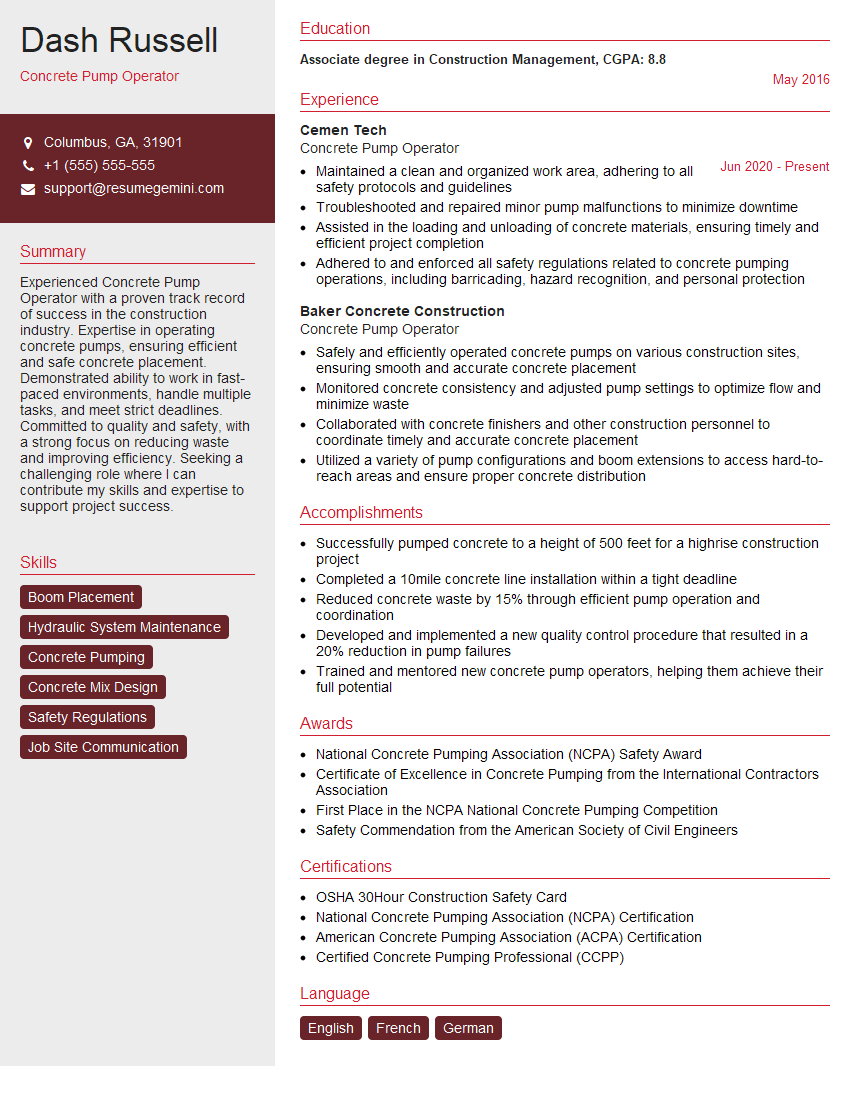Unlock your full potential by mastering the most common Construction Tool and Equipment Operation interview questions. This blog offers a deep dive into the critical topics, ensuring you’re not only prepared to answer but to excel. With these insights, you’ll approach your interview with clarity and confidence.
Questions Asked in Construction Tool and Equipment Operation Interview
Q 1. Describe your experience operating an excavator.
My experience with excavators spans over 10 years, encompassing various models and project types, from small-scale residential projects to large-scale infrastructure developments. I’m proficient in operating both hydraulic and cable excavators, adept at maneuvering in confined spaces, and experienced in various digging techniques, including trenching, excavating foundations, and loading trucks. For instance, on a recent highway expansion project, I used a 30-ton excavator to dig precise trenches for utility lines, ensuring minimal disruption to existing infrastructure while adhering to strict safety and environmental regulations. My skills also extend to utilizing various excavator attachments, such as breakers, grapples, and augers, to enhance efficiency and versatility on the jobsite.
I understand the nuances of different digging techniques based on soil conditions, optimizing fuel efficiency and minimizing equipment wear. One example of this was on a site with particularly hard clay. I adjusted my digging technique and used a hydraulic breaker to help loosen the material before excavating, improving both efficiency and safety.
Q 2. Explain the pre-operational checks you perform on a bulldozer.
Pre-operational checks on a bulldozer are critical for safety and efficiency. My routine begins with a thorough visual inspection, checking for any leaks, damage, or loose components. I then inspect the tracks for wear and tear, looking for any potential issues that could compromise stability. I check fluid levels – engine oil, hydraulic fluid, coolant – ensuring they are within the manufacturer’s specified ranges. I test all controls, including the blade, steering, and throttle, ensuring they function smoothly and respond correctly. The lights and horn are tested for functionality. Finally, a crucial step is checking the condition of the blade itself, confirming its alignment and ensuring it is free of any debris that might interfere with its operation. This thorough process ensures safe and efficient operation, minimizing the risk of breakdowns and accidents.
Q 3. What safety procedures do you follow when operating a crane?
Crane operation demands meticulous adherence to safety protocols. Before starting any lift, I perform a comprehensive pre-operational check, including inspecting the crane’s structure, cables, hooks, and load-bearing mechanisms for any signs of damage or wear. I verify the weight of the load using approved scales and ensure it’s within the crane’s lifting capacity. Clear communication with the ground crew is essential, utilizing hand signals or a two-way radio to coordinate movements and ensure everyone is aware of the lift’s trajectory. The load chart is strictly adhered to, ensuring all operations are performed within the crane’s safe working limits. A designated signal person is always present to guide the operation. Furthermore, I ensure the area around the crane is clear of obstructions and personnel, creating a safe working zone. Finally, regular inspections of the crane itself are a critical part of safety. I wouldn’t start work without a thorough inspection.
Q 4. How do you handle unexpected equipment malfunctions?
Dealing with unexpected equipment malfunctions requires a calm and methodical approach. My first step is to immediately shut down the equipment and assess the situation without putting myself or others at risk. If the problem is minor, like a loose bolt, I might be able to address it myself, but only if I am trained to do so and if I can do it safely. Otherwise, I immediately report the malfunction to my supervisor, providing a detailed description of the issue and its location. I then follow company protocols for reporting equipment failure, which usually involves filling out a detailed incident report. In the meantime, I secure the equipment to prevent further damage or injury and wait for assistance from a qualified mechanic or technician. Safety is paramount throughout this process, ensuring the equipment remains secured and is not operated until it’s deemed safe to do so by a qualified individual.
Q 5. Describe your experience with different types of loaders.
My experience encompasses various loaders, including wheel loaders, skid steer loaders, and backhoe loaders. Wheel loaders are my most frequent choice for large-scale material handling, like moving soil or aggregates on construction sites. Their high capacity and mobility make them efficient for these tasks. Skid steers are invaluable for their maneuverability in tight spaces, perfect for finishing work or tasks where space is limited. I’ve used backhoe loaders extensively for excavation and trenching work, appreciating their versatility for both digging and loading. Each loader type possesses unique characteristics, and selecting the appropriate machine is crucial for maximizing efficiency and safety. For instance, the wheel loader is perfect for bulk earthmoving on a large site, while the backhoe is better suited to more precise digging of trenches for utilities.
Q 6. What are the limitations of a skid steer?
Skid steers, while highly versatile and maneuverable, have limitations. Their lifting capacity is relatively low compared to larger loaders, restricting the size and weight of materials they can handle. Their stability can be compromised on uneven terrain, limiting their effectiveness in challenging environments. The relatively small size of the machine and its limited reach may restrict the scope of work on larger projects. In contrast to heavier equipment, skid steers are also not suitable for large-scale earthmoving or heavy lifting tasks. They are best suited for precise work in constrained spaces, not for moving mountains of dirt.
Q 7. Explain the proper techniques for operating a concrete pump.
Operating a concrete pump requires a systematic approach, starting with a thorough inspection of the pump’s components, including the hoses, pipes, and the boom itself. Before initiating the pumping process, it’s essential to ensure that the concrete mix is suitable for pumping and that the receiving area is adequately prepared. The pumping process needs to be carefully monitored, and the pressure should be regulated to prevent blockages or damage to the equipment. Smooth and steady operation of the boom is crucial to place the concrete precisely in the desired location, which minimizes waste and ensures quality. Regular cleaning and maintenance are critical to prolong the life of the pump and ensure its smooth operation. Improper maintenance can lead to costly repairs or even site delays. A good operator understands the interplay of pressure, flow rate, and boom movement to create a smooth concrete placement.
Q 8. How do you ensure the stability of an aerial lift?
Ensuring the stability of an aerial lift is paramount for safety. It involves a multi-faceted approach, beginning with proper setup and extending to mindful operation. Think of it like building a sturdy tower – you wouldn’t stack blocks unevenly!
- Level Ground: Always position the lift on a firm, level surface. Uneven ground can destabilize the machine, leading to tipping. I always check the ground’s stability before even beginning setup.
- Outriggers (if applicable): Extend outriggers fully and ensure they are firmly planted on the ground. Think of them as the legs of a tripod; wider the base, greater the stability. I always double-check that the outrigger indicators show full extension and solid ground contact.
- Load Capacity and Distribution: Never exceed the lift’s weight capacity. Distribute the load evenly within the platform. Imagine it as balancing a scale – uneven weight distribution creates an imbalance and increases the risk of tipping. I always meticulously calculate the weight of materials and personnel before lifting.
- Wind Conditions: Avoid operating aerial lifts in high winds. Wind acts like a powerful force trying to topple the lift. I always consult weather reports and postpone operations if winds exceed safe limits. A gentle breeze is manageable, but strong winds are unacceptable.
- Proper Operation: Smooth movements, controlled lifting and lowering, and avoiding jerky motions are crucial. Sudden movements can create instability and lead to accidents. Smooth and careful operation is always my top priority.
By meticulously following these steps, I ensure the aerial lift remains stable and safe throughout operation.
Q 9. What maintenance tasks can you perform on a forklift?
Forklift maintenance is crucial for preventing costly repairs and ensuring operational safety. Think of it like regular car maintenance – neglecting it leads to bigger problems down the road.
- Daily Inspections: I always start with a visual inspection, checking for fluid leaks, tire pressure, damage to the forks or mast, and overall structural integrity. This is my first line of defense against potential issues.
- Fluid Checks and Changes: Regularly check and change engine oil, hydraulic fluid, and coolant according to the manufacturer’s recommendations. These fluids are the lifeblood of the forklift, ensuring smooth operation.
- Tire Maintenance: Inspect tires for wear and tear, proper inflation, and any damage. Proper tire pressure is essential for stability and operational efficiency.
- Battery Maintenance (for electric forklifts): Check battery water levels, clean terminals, and ensure proper charging procedures. A fully charged and well-maintained battery is vital for electric forklifts.
- Brake System Inspection: Regularly inspect the brake system for wear and proper functioning. Proper brakes are non-negotiable for safe operation.
- Mast and Fork Inspection: Check for any bending, cracks, or damage to the mast and forks. Damaged parts must be repaired or replaced immediately.
Beyond these daily tasks, I also participate in scheduled preventative maintenance, including more in-depth inspections and component replacements as needed. This proactive approach ensures the long-term reliability and safety of the forklift.
Q 10. Describe your experience with GPS-guided equipment.
I have significant experience operating GPS-guided equipment, primarily on large-scale grading and earthmoving projects. This technology significantly improves accuracy and efficiency. Think of it as having a highly skilled navigator constantly guiding your machine.
For example, on a recent highway construction project, we used GPS-guided bulldozers and graders. The GPS system provided real-time positioning data, allowing operators to precisely follow the designed grade and contours, minimizing rework and material waste. This system drastically cut down on the amount of time spent manually checking grades and adjusting equipment, resulting in a significant increase in productivity and cost savings.
The precision of GPS guidance enables the creation of smoother, more accurate surfaces, resulting in a higher quality end product and reduced need for post-construction adjustments. The system also includes features that alert the operator to potential issues, such as approaching predefined boundaries, preventing costly errors and increasing safety. I’m highly proficient in using and interpreting the data provided by GPS-guided equipment and adept at troubleshooting common issues associated with its usage.
Q 11. How do you calculate the required fuel for a specific task?
Calculating fuel requirements for a specific task involves several factors. It’s not just a simple formula; you need to consider the specifics of the job.
- Equipment Type and Model: Different machines have different fuel consumption rates. Consult the manufacturer’s specifications for fuel consumption per hour of operation. This is your starting point.
- Task Duration: Estimate the total time required to complete the task. This is crucial, as the fuel consumption is directly proportional to the operational time.
- Operational Conditions: Terrain type, weather conditions (e.g., working uphill consumes more fuel), and load size all influence fuel consumption. Tougher terrain means higher fuel consumption.
- Idle Time: Account for idle time during the task. The machine still consumes fuel while idle.
Example: Let’s say a bulldozer consumes 10 gallons of fuel per hour, and the task will take 5 hours, including 1 hour of idle time. The total fuel consumption would be (5 hours * 10 gallons/hour) = 50 gallons. However, in reality, we’d add a safety margin of about 10-15% to account for unforeseen circumstances.
Therefore, accurate fuel calculation requires careful consideration of all relevant factors, resulting in a detailed estimate, not just a simple calculation.
Q 12. What are the different types of grading techniques?
Grading techniques are diverse, each suited for different conditions and objectives. Think of them as different tools in a toolbox, each with its own specific application.
- Cut and Fill: This is the most common method, involving cutting material from high areas and filling low areas to create a level surface. It’s like sculpting land to achieve the desired grade.
- Finish Grading: This is the final stage, achieving precise levels and smooth surfaces. It’s like polishing a piece of wood to achieve a perfectly smooth finish.
- Slope Grading: This method creates sloped surfaces, essential for drainage and stability. It’s like creating a gentle incline for water runoff.
- Bank Grading: Involves shaping earth banks, often used for road construction or retaining walls. It’s like carefully shaping the sides of a ditch or embankment.
- Sub-grading: Preparing a level base for foundations or pavements. It’s like creating a sturdy and even platform for construction.
The choice of grading technique depends on the project’s specific requirements, the available equipment, and the site conditions. Experienced operators, like myself, are adept at selecting and executing the most efficient and effective technique for any given scenario.
Q 13. Explain the importance of daily equipment inspections.
Daily equipment inspections are fundamental for safety and preventing costly breakdowns. It’s like a health checkup for your machine, identifying potential problems before they escalate.
A thorough inspection includes checking fluid levels (oil, hydraulic fluid, coolant), tire pressure, brake function, and visual inspections for any damage to the machine’s structure, components, or attachments. I also check the lights, warning signals, and safety features. This proactive approach ensures that any minor issue is caught early, preventing it from becoming a major problem.
The importance lies in early problem detection. A small leak discovered early can prevent a major hydraulic failure, and a damaged part can be repaired before causing more extensive damage or creating a safety hazard. Proper documentation of these inspections is crucial for tracking maintenance and providing historical data, valuable for preventative maintenance planning.
Q 14. How do you handle challenging terrain with heavy equipment?
Handling challenging terrain with heavy equipment requires skill, experience, and careful planning. It’s like navigating a difficult trail – you need to know your vehicle’s capabilities and plan your route accordingly.
- Proper Equipment Selection: Choosing the right machine for the terrain is paramount. A tracked vehicle performs better in mud or loose soil than a wheeled machine, for instance.
- Route Planning: Carefully assess the terrain, plan the route, and identify potential obstacles. I always scout the area first before committing to a route.
- Speed and Traction: Maintain a safe speed appropriate for the terrain. Using the right speed and throttle helps to maintain traction.
- Terrain Awareness: Be constantly aware of the terrain’s slope, consistency, and potential hazards such as rocks, ditches, or soft spots. I constantly monitor the ground’s condition and adapt my driving style accordingly.
- Use of Accessories: Use appropriate accessories like counterweights or specialized tracks to enhance stability and traction. Depending on the terrain, additional equipment can significantly improve performance.
Operating heavy equipment on challenging terrain always demands caution and skillful maneuvering. Experience and careful assessment are essential for safe and efficient operation.
Q 15. Describe your experience with different types of backhoes.
My experience with backhoes spans over a decade, encompassing various models and applications. I’m proficient in operating both wheel and crawler-mounted backhoes, from smaller models suitable for utility work to larger excavators used in large-scale construction projects. This includes familiarity with different control systems – both mechanical and hydraulic – and an understanding of their nuances. For instance, I’ve used Case 580 Super Ms for trenching and smaller John Deere models for landscaping. The key difference in operation usually boils down to the size and power, influencing the type of projects they are best suited for. Larger machines need more careful maneuvering due to their greater reach and potential for damage.
I’ve worked extensively with different attachments, such as rippers for breaking up hard ground, augers for drilling holes, and various buckets for different material types. My experience extends to understanding the maintenance requirements of these machines, ensuring their optimal performance and longevity. I’ve even troubleshooted minor mechanical issues on-site, saving valuable time and resources. In essence, I’m not just an operator; I’m a knowledgeable and resourceful member of the construction team.
Career Expert Tips:
- Ace those interviews! Prepare effectively by reviewing the Top 50 Most Common Interview Questions on ResumeGemini.
- Navigate your job search with confidence! Explore a wide range of Career Tips on ResumeGemini. Learn about common challenges and recommendations to overcome them.
- Craft the perfect resume! Master the Art of Resume Writing with ResumeGemini’s guide. Showcase your unique qualifications and achievements effectively.
- Don’t miss out on holiday savings! Build your dream resume with ResumeGemini’s ATS optimized templates.
Q 16. What are the safety regulations for operating heavy machinery?
Safety regulations for operating heavy machinery are paramount and vary slightly depending on location and specific equipment, but some core principles remain consistent. Before starting any operation, a thorough pre-operational inspection is mandatory. This involves checking fluid levels (hydraulic, engine oil, coolant), tire pressure (for wheeled machines), brakes, lights, and ensuring all safety features, such as seatbelts and emergency stops, are in working order. Operating these machines requires valid certification and adhering to all site-specific safety rules.
During operation, maintaining a safe distance from other workers and equipment is crucial. Blind spots must be constantly accounted for, and appropriate hand signals must be used when working with others. Operating within the machine’s design limits (load capacity, terrain suitability) is essential to avoid accidents. Regular training and awareness of potential hazards, such as overhead power lines and unstable ground, are continuously refreshed through company safety protocols and training sessions. Failure to adhere to these safety regulations can lead to serious injuries and project delays.
Q 17. How do you ensure the safety of yourself and others on the job site?
Ensuring the safety of myself and others on the job site is my top priority. I always conduct thorough pre-operational checks on the equipment, as mentioned before. This includes making sure the area around the machine is clear of obstacles and personnel before starting work. I use warning devices, such as lights and cones, to alert others of my presence and movements. I actively communicate with other workers, using clear hand signals and radio communication to coordinate activities. I also strictly adhere to all site-specific safety regulations and procedures.
I actively participate in regular safety meetings and training sessions to stay updated on the latest safety procedures and best practices. I never hesitate to stop work if I sense a potential hazard or if unsafe conditions exist. For example, if the ground appears unstable, I’ll immediately report the issue and refuse to continue operating until it’s resolved. Proactive risk assessment is a crucial part of my daily work routine, ensuring a safe working environment for everyone. Safety is not just a rule; it’s a core value integrated into every aspect of my work.
Q 18. What is your experience with different types of rollers?
My experience with rollers includes operating various types, including static (or smooth drum) rollers, pneumatic tired rollers, and vibratory rollers. Static rollers are primarily used for compacting base materials, while pneumatic rollers are better for more granular materials like asphalt. Vibratory rollers are effective for both base and asphalt compaction due to their ability to increase density. Each type requires a different operating technique to achieve optimal compaction. For example, overlapping passes are crucial for effective compaction with any roller type, ensuring even density across the entire surface.
The specific roller chosen depends heavily on the material being compacted and the desired level of compaction. I understand the importance of adjusting speed and pressure depending on the type of roller and material. Incorrect usage can lead to uneven compaction and structural weaknesses, impacting the long-term durability of the project. I’ve used Bomag and Hamm brand rollers extensively and am familiar with their performance characteristics and maintenance requirements.
Q 19. Describe your experience with different types of excavators.
My experience with excavators is extensive, covering both crawler-type and wheeled excavators, from small mini-excavators used in confined spaces to large hydraulic excavators used in massive earthmoving projects. I am comfortable operating machines equipped with various attachments, including different sized buckets, rippers, and hydraulic breakers. The differences in operation between crawler and wheeled excavators mainly lie in maneuverability and terrain suitability. Crawler excavators excel in rough and uneven terrain, offering superior stability, while wheeled excavators are more agile and ideal for moving quickly between locations on level ground.
Operating an excavator requires precise control and awareness of the machine’s limitations. Factors like ground conditions, load weight, and the stability of the machine are constantly evaluated to prevent tipping or other accidents. I’ve worked with various brands such as Caterpillar, Komatsu, and Hitachi, understanding the nuances of each machine’s controls and capabilities. My experience also extends to understanding and implementing different excavation techniques depending on the type of soil and the project’s requirements, such as trenching, mass excavation, and precise digging for foundation work.
Q 20. What is your understanding of load capacity and stability?
Understanding load capacity and stability is critical for safe and efficient operation of heavy machinery. Load capacity refers to the maximum weight a machine can lift or carry without compromising its structural integrity or stability. This information is usually found in the operator’s manual and is crucial for avoiding overloading, which can lead to equipment failure or tipping. Stability refers to the machine’s resistance to tipping or overturning. It is affected by factors such as the machine’s weight distribution, the type of terrain, and the position of the load.
For example, operating an excavator on a slope requires careful consideration of the load’s position and the machine’s center of gravity to maintain stability. Exceeding the load capacity or operating in conditions that compromise stability can result in serious accidents, property damage, and injuries. Therefore, I always check the machine’s specifications, monitor the load weight and the machine’s position, and adjust my operation accordingly to ensure both load capacity and stability are within safe limits. I always prioritize safety over speed or efficiency.
Q 21. How do you read and interpret blueprints and plans for equipment use?
Reading and interpreting blueprints and plans is a crucial skill for effective equipment use in construction. Blueprints provide essential information about the project layout, dimensions, and the locations where specific equipment will be used. They indicate details like excavation depths, the location of utilities (water pipes, electrical cables), and the required grades for roads and other structures. I’m proficient in interpreting various symbols, notations, and scales commonly used in construction drawings. For instance, understanding contour lines on a site plan is vital for planning excavation and grading operations.
Before operating any equipment, I carefully review the relevant plans to understand the scope of work and to identify any potential hazards. I use the blueprints to determine the optimal location for equipment placement, minimizing the risk of damage to existing structures or interfering with other operations. This includes identifying areas that might require additional precautions due to difficult terrain or the presence of underground utilities. Careful review of plans prevents errors, improves safety, and enhances the overall efficiency of the construction process. It is a fundamental element in responsible equipment operation.
Q 22. Describe a time you had to troubleshoot a major equipment problem.
During a large-scale excavation project, the main excavator’s hydraulic system experienced a sudden failure. The boom stopped responding, leaving a partially excavated trench and halting the entire operation. Troubleshooting involved a systematic approach.
- Initial Assessment: I first checked the obvious – hydraulic fluid levels, for leaks, and listened for unusual noises. Everything appeared normal at first glance.
- Systematic Investigation: I then moved to the hydraulic control panel, checking pressure gauges, circuit breakers, and warning lights. A low pressure reading in the boom circuit indicated a problem.
- Pinpointing the Issue: I traced the hydraulic lines from the control valve to the boom cylinder, carefully inspecting for any damage or blockages. I discovered a small, almost imperceptible crack in a high-pressure line, causing a slow leak and loss of pressure.
- Solution: Due to the critical nature and the impossibility of an immediate repair in the field, I contacted our supervisor and the equipment maintenance team. They arranged for the replacement of the damaged line. We also implemented additional safety measures to ensure similar incidents were prevented.
This experience highlighted the importance of both methodical troubleshooting and clear communication within a team. It showed me the cost of downtime and emphasized the necessity of preventative maintenance to avoid such critical failures.
Q 23. Explain your knowledge of hydraulic systems in construction equipment.
Hydraulic systems are the lifeblood of many construction machines, providing the power for lifting, digging, and other functions. My understanding encompasses several key aspects:
- Components: I’m familiar with the major components such as pumps, valves (directional control, pressure relief, check), cylinders, actuators, and hydraulic fluid reservoirs. I understand their functions and how they interact within the system. For instance, I know the difference between open-center and closed-center hydraulic systems and their applications.
- Fluid Dynamics: I have a good grasp of Pascal’s principle and how hydraulic pressure is used to generate force. Understanding pressure, flow rate, and viscosity is critical for efficient operation and trouble-shooting.
- Troubleshooting: As explained in the previous answer, I can diagnose problems by checking fluid levels, pressure gauges, and listening for leaks or unusual noises. I can identify potential issues with components such as failing pumps, worn seals, or clogged filters. I’m adept at using diagnostic tools like pressure gauges and flow meters.
- Safety: I’m well-versed in safety procedures related to working with high-pressure hydraulic systems, including proper lockout/tagout procedures and the handling of hydraulic fluids which can be hazardous.
For example, I once diagnosed a problem on a backhoe where the bucket wouldn’t curl due to a faulty directional control valve. By carefully examining the hydraulic circuit and using a pressure gauge, I determined the valve’s internal spool was stuck, requiring its replacement.
Q 24. How do you manage your time effectively when operating multiple pieces of equipment?
Managing time effectively when operating multiple pieces of equipment often involves careful planning and prioritization. It’s like conducting an orchestra – each instrument (piece of equipment) needs attention and coordination.
- Prioritization: I start by assessing the tasks and prioritizing those with the most immediate deadlines or highest impact on the project schedule.
- Task Sequencing: I sequence tasks logically to minimize travel time and equipment changes. For example, I’ll complete tasks near each other with the same piece of equipment before switching.
- Preemptive Planning: Before beginning, I’ll prepare materials and tools for each task. This preparation reduces downtime and prevents delays due to missing equipment.
- Regular Checks: I make short, regular checks of each equipment’s fuel and fluid levels, checking for early signs of malfunction. Regular maintenance shortens repairs and reduces downtime later.
- Communication: Regular communication with the team ensures that we’re all aligned and aware of any potential roadblocks that could impact my workflow or others’ work.
For example, when working on a road construction project, I might use a grader to level the ground first, then utilize a compactor to compact the soil, followed by the paver to lay the asphalt, minimizing transition times between tasks.
Q 25. How do you communicate effectively with your team and supervisors?
Effective communication is essential in construction. I use a multi-faceted approach:
- Clear and Concise Language: I avoid technical jargon when speaking to non-technical personnel, ensuring everyone understands the message. I use diagrams and visual aids when helpful.
- Active Listening: I actively listen to my team and supervisors, ensuring I understand their instructions and concerns. Asking clarifying questions is crucial.
- Regular Check-ins: I provide regular updates on my progress and any challenges I encounter. Proactive reporting prevents unexpected delays.
- Respectful Dialogue: I maintain a respectful and professional tone, even when discussing difficult issues. Open and honest communication builds trust and collaboration.
- Non-Verbal Communication: I use body language to convey messages effectively, showing attentiveness and understanding during conversations.
A clear example is when a change order arises during a project. I listen carefully, ask clarifying questions, and confirm that I understand the modifications before proceeding, ensuring everyone is on the same page and potential conflicts are resolved promptly.
Q 26. Describe your experience working with different types of soil and terrain.
My experience working with diverse soil and terrain conditions is extensive. Understanding soil type is paramount for selecting the appropriate equipment and techniques. Here’s a breakdown:
- Soil Types: I’ve worked with various soils, including clay (which can be very sticky and difficult to work with), sandy soils (easier to excavate but can be prone to erosion), loamy soils (a balanced mix generally easier to work with), and rocky soils (requiring specialized equipment like rock breakers).
- Terrain: I’ve operated equipment on level ground, steep inclines, and uneven terrain. I’m experienced in adapting operation techniques to accommodate the specific challenges of each condition.
- Equipment Adaptation: I’m skilled at choosing the right equipment for each situation. For instance, a smaller excavator might be preferable for tight spaces, while a larger one is needed for large-scale excavations. The type of bucket used also varies based on the soil type and material being handled.
- Safety Considerations: Safety is a primary concern. I understand the risks associated with working on slopes, uneven ground, and in challenging conditions. I always follow safety protocols and use appropriate safety equipment.
For instance, working on a hillside required me to adjust the excavator’s operation to avoid destabilizing the slope. I worked methodically, in short controlled movements, ensuring safety and avoiding potential hazards.
Q 27. What is your experience with preventative maintenance?
Preventative maintenance is crucial for maximizing equipment lifespan and minimizing downtime. My approach is proactive and systematic:
- Daily Inspections: I perform thorough daily inspections of all equipment I operate, checking fluid levels, tire pressure, wear and tear on components, and looking for any signs of damage or leaks.
- Scheduled Maintenance: I adhere to the manufacturer’s recommended maintenance schedule for each piece of equipment, including regular lubrication, filter changes, and other necessary procedures. I meticulously record all maintenance activities.
- Reporting Issues: Any potential issues identified during inspections are immediately reported to the supervisor or maintenance team to prevent them from becoming major problems. Early detection and reporting save significant time and money.
- Operator Care: I practice good operating techniques to minimize wear and tear on equipment, avoiding harsh or sudden movements. Proper handling is essential.
By following this routine, I’ve contributed to extending the operational life of construction equipment and avoided costly repairs, contributing to the overall efficiency and success of projects.
Q 28. What is your experience working in different weather conditions?
Operating construction equipment in diverse weather conditions is a regular part of the job, and safety is the most critical element in such conditions.
- Extreme Temperatures: I’ve worked in both scorching summer heat and freezing winter conditions. In hot weather, I stay hydrated and take regular breaks to prevent heat exhaustion. In cold weather, I layer clothing appropriately to maintain body temperature, and I carefully monitor equipment for issues related to cold temperatures (like battery performance).
- Precipitation: I adjust my operating techniques based on rainfall or snow. For example, in wet conditions, I operate more slowly to maintain control and avoid slips or slides. I ensure adequate visibility and watch out for potential hazards like mud or ice.
- Wind: High winds can affect equipment stability and operations, especially when using taller machines. I take extra precautions in windy conditions to ensure safe operation.
- Safety Protocols: My safety training emphasizes operating procedures for different weather situations. This includes things like adjusting working hours to accommodate extreme conditions, using additional lighting during low-light periods, and using appropriate safety gear in all conditions.
During a particularly heavy snowstorm, I carefully assessed the situation and coordinated with the team to halt operations when conditions became unsafe, demonstrating responsible prioritization of team safety above project deadlines.
Key Topics to Learn for Construction Tool and Equipment Operation Interview
- Safe Operation Procedures: Understanding and applying safety regulations for various equipment, including pre-operational checks, emergency procedures, and lockout/tagout protocols.
- Equipment Maintenance & Troubleshooting: Practical knowledge of routine maintenance tasks, identifying common malfunctions, and performing basic repairs on equipment like excavators, loaders, and bulldozers. This includes understanding preventative maintenance schedules.
- Specific Equipment Expertise: Demonstrating proficiency with specific tools and equipment relevant to the job description (e.g., backhoe operation, crane operation, forklift operation, concrete mixer operation). Be prepared to discuss your experience level with each.
- Understanding of Construction Drawings & Plans: Interpreting blueprints and construction plans to understand equipment placement, material handling requirements, and project timelines.
- Material Handling Techniques: Safe and efficient methods for loading, unloading, transporting, and storing construction materials using appropriate equipment.
- Environmental Awareness: Understanding and adhering to environmental regulations and best practices related to construction site operations, including waste disposal and emissions control.
- Teamwork and Communication: Highlighting your ability to collaborate effectively with other crew members, communicate clearly, and follow instructions.
- Problem-Solving and Decision-Making: Demonstrating your ability to identify and solve problems related to equipment malfunction, site challenges, and safety concerns on the job site.
Next Steps
Mastering Construction Tool and Equipment Operation is crucial for career advancement in the construction industry. Proficiency in this area opens doors to higher-paying positions, increased responsibilities, and greater job security. To maximize your job prospects, creating a strong, ATS-friendly resume is essential. ResumeGemini is a trusted resource that can help you build a professional and effective resume tailored to your skills and experience. Examples of resumes specifically designed for Construction Tool and Equipment Operation professionals are available to help you get started.
Explore more articles
Users Rating of Our Blogs
Share Your Experience
We value your feedback! Please rate our content and share your thoughts (optional).
What Readers Say About Our Blog
Hello,
We found issues with your domain’s email setup that may be sending your messages to spam or blocking them completely. InboxShield Mini shows you how to fix it in minutes — no tech skills required.
Scan your domain now for details: https://inboxshield-mini.com/
— Adam @ InboxShield Mini
Reply STOP to unsubscribe
Hi, are you owner of interviewgemini.com? What if I told you I could help you find extra time in your schedule, reconnect with leads you didn’t even realize you missed, and bring in more “I want to work with you” conversations, without increasing your ad spend or hiring a full-time employee?
All with a flexible, budget-friendly service that could easily pay for itself. Sounds good?
Would it be nice to jump on a quick 10-minute call so I can show you exactly how we make this work?
Best,
Hapei
Marketing Director
Hey, I know you’re the owner of interviewgemini.com. I’ll be quick.
Fundraising for your business is tough and time-consuming. We make it easier by guaranteeing two private investor meetings each month, for six months. No demos, no pitch events – just direct introductions to active investors matched to your startup.
If youR17;re raising, this could help you build real momentum. Want me to send more info?
Hi, I represent an SEO company that specialises in getting you AI citations and higher rankings on Google. I’d like to offer you a 100% free SEO audit for your website. Would you be interested?
Hi, I represent an SEO company that specialises in getting you AI citations and higher rankings on Google. I’d like to offer you a 100% free SEO audit for your website. Would you be interested?
good
